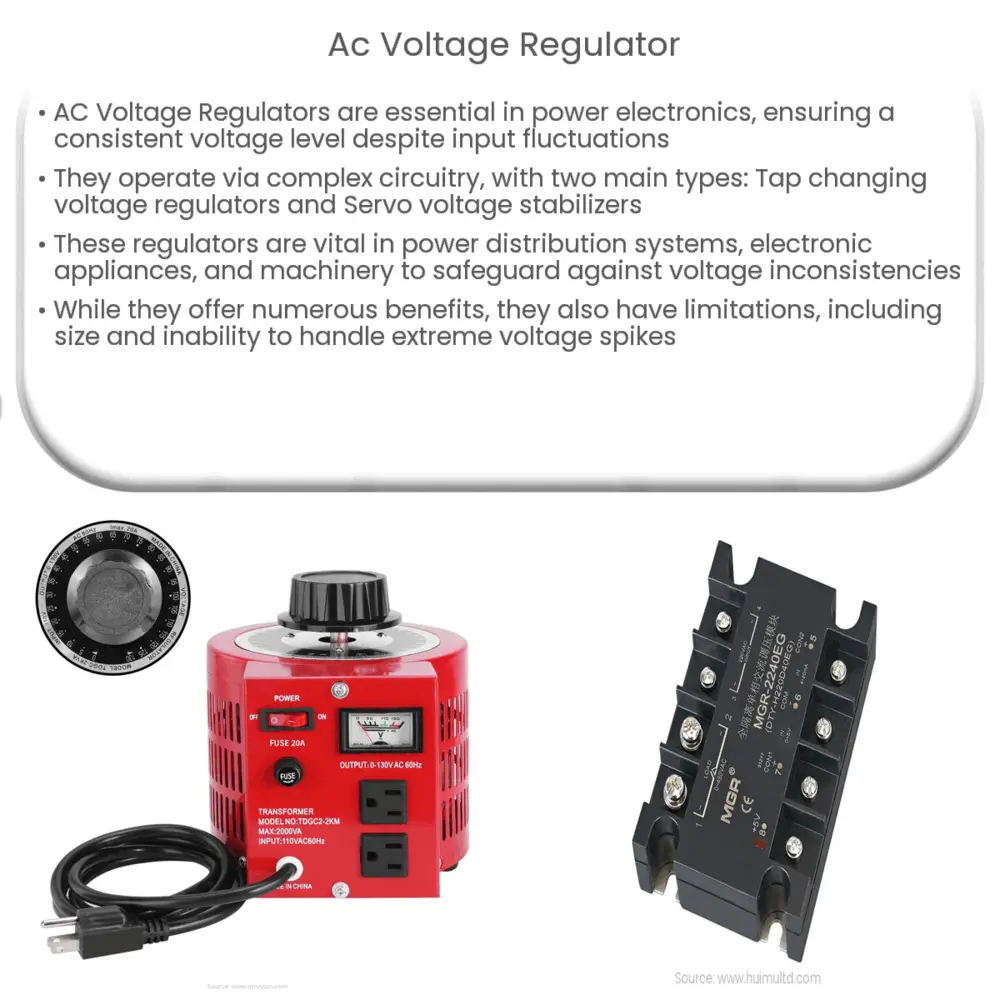Explore the world of AC Voltage Regulators, their operation, applications, features, benefits, limitations, and their vital role in power electronics.

Understanding AC Voltage Regulators
An AC Voltage Regulator is an essential component in the realm of power electronics, serving as a key device in maintaining consistent and safe levels of voltage. Before diving into the specifics of an AC Voltage Regulator, it’s crucial to understand the general concept of voltage regulation.
Voltage regulation is the process by which the output voltage of an electrical system is maintained within a defined range, despite variations in input voltage or load conditions. In other words, it ensures that the output voltage remains steady and unchanged, regardless of fluctuations in the input voltage or the amount of power drawn by the load.
How AC Voltage Regulators Work
An AC voltage regulator operates on the principles of regulating and adjusting the input AC voltage to deliver a constant output AC voltage, regardless of the fluctuations in input voltage or load. This is achieved through a complex circuitry design, which includes components such as transformers, diodes, transistors, and zener diodes.
AC Voltage Regulators are generally classified into two main types: Tap changing voltage regulators and Servo voltage stabilizers.
- Tap changing voltage regulators: These regulate the voltage by changing the turns ratio of the transformers, effectively altering the output voltage.
- Servo voltage stabilizers: These use a servo motor to adjust the voltage to the desired level.
Applications of AC Voltage Regulators
AC voltage regulators find application in a plethora of electrical and electronic devices. They are commonly employed in power distribution systems, where they are used to maintain a steady supply of power to residences, commercial buildings, and industrial facilities. In these settings, they can prevent harmful voltage drops or spikes, protecting sensitive equipment from potential damage.
Furthermore, AC voltage regulators are widely utilized in electronic appliances, such as televisions and refrigerators, and in various types of machinery to ensure the smooth and efficient operation of these devices. They are particularly important in devices with sensitive electronic components that could be damaged by voltage fluctuations.
That’s the overview of AC Voltage Regulators. In the next part, we will delve into the various features, benefits and limitations of AC Voltage Regulators.
Features of AC Voltage Regulators
AC voltage regulators come with several advantageous features. They provide high accuracy in voltage regulation, with many models offering a regulation accuracy of ±1% or better. Moreover, these devices often have a wide input voltage range, allowing them to handle significant voltage fluctuations.
Additionally, AC voltage regulators are designed to operate over a broad range of frequencies, making them versatile and adaptable. Many regulators also have short-circuit and overload protection mechanisms, ensuring they can safely manage unexpected electrical faults without causing damage to themselves or the equipment they’re connected to.
Benefits of AC Voltage Regulators
The benefits of using AC voltage regulators are manifold. Primarily, they protect sensitive electronic devices from voltage fluctuations, which could otherwise lead to malfunctions or damage. This makes them indispensable in settings where the consistency and stability of power supply are paramount, such as hospitals and data centers.
Furthermore, AC voltage regulators can enhance the lifespan and efficiency of electrical equipment by providing a stable power supply, reducing the wear and tear caused by voltage fluctuations. They also play a crucial role in reducing energy waste, thereby contributing to energy efficiency.
Limitations of AC Voltage Regulators
Despite their many advantages, AC voltage regulators are not without their limitations. They can be quite complex and bulky, especially in high-power applications, which may pose challenges in terms of installation space. Moreover, depending on the technology used, they might generate heat and noise during operation.
Another limitation is that AC voltage regulators cannot compensate for a complete loss of power or for very high voltage spikes, often experienced during lightning strikes. For these situations, other protective devices, such as surge protectors and Uninterruptible Power Supply (UPS) systems, are needed.
Conclusion
In conclusion, AC Voltage Regulators play a vital role in our power-reliant society, offering a buffer against the inconsistencies and fluctuations in the power supply. From safeguarding delicate electronic devices to ensuring the stable operation of critical infrastructure, their importance can’t be overstated.
While they do have some limitations, the benefits they provide in maintaining a steady, reliable power supply far outweigh these drawbacks. As technology continues to evolve, we can expect further enhancements in AC voltage regulators, increasing their efficiency and applicability across various sectors.

